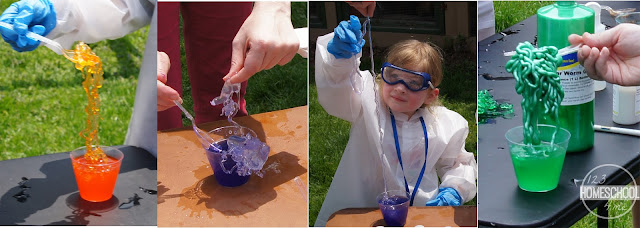This year for my son's 11th birthday we threw a science party.
It was so much fun!
The party was easy to do, fun for the kids, and (sh, don't tell) but educational too!
Science Party
As most of our party was outside, we kept the decorating simple. We used a science birthday banner, science balloons, coordinating crepe paper, science plates, our microscope, and various beakers filled with chex mix and coordinating colored sixlets (found at Walmart in party isle)
The cake was a 2 layer chocolate cake with our homemade buttercream frosting. I added his name using this nifty find your name in the periodic table of elements by frosting square cookies to be each of the elements we needed.
The top was our favorite part - it s a white chocolate gelatin BRAIN! We used this recipe (subbing white chocolate) and adding food coloring for the brain and used this brain mold. It was super easy! We left the brain in the mold until right before the party then we dipped the mold in warm water and it slid right out!
We also made some vanilla cupcakes to make sure we had enough cake for our 20+ guests. We frosted them the same colored buttercream frosting and topped with candy DNA using licorice, colored mini marshmallows and toothpicks. The kids thought they were awesome!
We had a disposable labcoat, goggles, gloves, and ID for each of the 10 kids at the party. Not only did this add to the fun and excitement, but it kept them safe and clean!
Here are our scientists ages 5-11 ready to have some fun experimenting! We did all of our activities outside to keep the mess easy to cleanup! My sweet hubby dressed up as a mad scientist to add to the fun!
We started with this classic experiment using a 2L bottle of diet coke and 13 Mentos that we quickly dropped in to make this awesome geyser!
Then the kids got to try the experiment. We had 1L bottles of soda for the kids to try with 6-7 Mentos each. We let them pick between Diet Mountain Dew, Pepsi, Coke, and Root Beer and let them make hypothesis of which would go the highest.
Hint: Make sure they erupt at the same time or the kids will get messy!
All the carbon dioxide in the soda (the fizz) is squeezed into the liquid
and looking for a way out quickly so it shoots up! We used Diet as it is less sticky.
Insta Worms Science Experiment
This Insta Worm Science Experiment we bought as a kit from Steve Spangler was a HUGE hit. The kids were super impressed with this experiment.
Hint: Make sure you put the food coloring in the quirt bottle and not in the cup.
Insta-Worms are made because
of polymers – specifically sodium alginate which is a long chain of molecules
called a polymer. This linking together of hundreds of sugar molecules is used
to thicken foods such as ice cream, pie, or gummy worms. (also used in dental
impression or medicine capsules)
DIY Lava Lamp Science Experiment
This is a very simple, but FUN science experiment. You will want to get a plastic test tube or container for each child. You fill most of the tub with vegetable oil, 1-2 teas water, and leave about 1" headroom at the top. Kids will then put a couple drops of food coloring and 1/2 Alkazelzar Tablet in top to make the bubbling action.
Oil and water molecules do
not mix. Even if you shake it the blobs will just get smaller, bust sill won’t
mix. The colored blobs are actually just colored water. The fizers create tiny
bubbles of carbon dioxide gas; they are less dense that oil so they rise to the
top, but once they pop they sink back down to the bottom again.
Slime Science Experiment
We used our favorite, 2 ingredient slime recipe for the kids to whip up their own, colorful slime!
Slime is a non-Newtonian
fluid. Newtonian fluids always behave the same depending on temperature, slime
as a non-Newtonian fluid because its viscosity is affected by force put on it
(squeezing and pressure)
Vinegar and Baking Soda Balloon Experiment
We reused the 1 L bottles and filled them with vinegar 2/3rd up. Then we put 1-2 TAB of baking soda in a balloon using a funnel. Carefully put the balloon over the top. When you pull the balloon straight up and the baking soda goes down the chemical reaction will cause the balloon to inflate.
Hint: You may want to encourage kids to hold the top of the bottle to make sure it doesn't shoot of like a rocket if the balloon isn't on tightly.
The
chemical reaction between the baking soda and the vinegar produces the gas
carbon dioxide. As the gas goes up into the balloon, it inflates it!
Similarly, we exhale carbon dioxide when we blow up balloons!
We also planned to do Kid Safe Elephant Toothpaste, but our 40% Hydrogen Peroxide didn't arrive soon enough, but that would be another fun experiment that would also reuse the bottles you already have!
After we did our science experiments we came in for the kids to sing happy birthday, eat some cake, and grab so snacks including these super cool Petri Dish Jello. Just whip up some Jello and pour into petri dishes, then add sprinkles and refrigerate until set. It looks like you are growing some bacteria! Such a fun snack!
For some more science fun, make sure to check out these Science Experiments:
- Make Plastic from Milk Science Experiment
- Kool Aid Rock Candy
- Crystal Rainbows Science Activity
- Frozen Rainbow Eruptions
- I Spy Simple Machines
- Lego Volcano
- DIY Constellations Projector
- Magnetic Field Sensory Bottle
- Edible Geodes
- Dancing Science Project
- Pop Rock Science Experiment






















